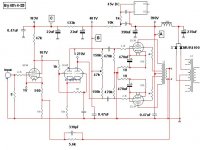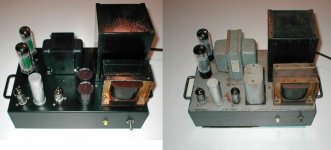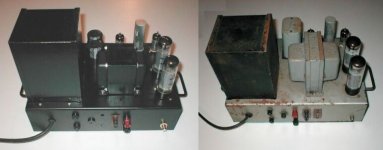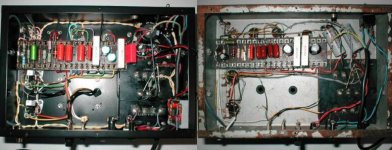The EF86 Mystery....
John,
I was thinking that JDev was implying that he had 'lost' two EF86s in the sense that they had been damaged. If the anode resistor goes high it shouldn't cause physical damage to the valve as such, and even if it shorted out, the 146 volts HT at this stage shouldn't cause the valve to collapse - and of course there would have been no output at all.
But 'losing?'
We need more information!
John,
I was thinking that JDev was implying that he had 'lost' two EF86s in the sense that they had been damaged. If the anode resistor goes high it shouldn't cause physical damage to the valve as such, and even if it shorted out, the 146 volts HT at this stage shouldn't cause the valve to collapse - and of course there would have been no output at all.
But 'losing?'
We need more information!
Re: The EF86 Mystery....
South African semantics
Cheers,
Ah, I just picked up on the cathode voltage gradually decreasing with time left running. That, in my experience, could be caused by a tired high value composition resistor.bournville said:John,
I was thinking that JDev was implying that he had 'lost' two EF86s in the sense that they had been damaged. If the anode resistor goes high it shouldn't cause physical damage to the valve as such, and even if it shorted out, the 146 volts HT at this stage shouldn't cause the valve to collapse - and of course there would have been no output at all.
But 'losing?'
We need more information!
South African semantics

Cheers,
Re: Amp modifications...
Sorry about the poor grammer, I "found" the correct word too late. I meant to say "optimize" and wanted the answer you gived me, about changing the resistor values. "Loosing" EF86; they seemed to stop working. I had 1 in the circuit, amp was working O.K. Then after a while , amp started to oscilate badly. I then swopped EF86 with spare 1. Worked fine for about 15min's, then also started to oscillate - I then assumed EF86 died because I measured oscilation direct after EF86 . So I got another 4 x EF86's, 3 org. Mullards for only $3-00 each and some other brand. I went through circuit again, testing all components. All tested fine, again. So I fit another EF86, worked fine, tried the "faulty" 1's again, now they were also good, again.
and some other brand. I went through circuit again, testing all components. All tested fine, again. So I fit another EF86, worked fine, tried the "faulty" 1's again, now they were also good, again. 
While testing another OT, an old 1 I got from some amp thing, I started to get oscillations again. Just by coincidence, I tried another load resistor, and oscillations were gone. My normal load resistor, which I always use on solid state amps, is a big 300Watt - 8ohm wirewound resistor - tube shaped. This 2nd resistor I used is a 40Watt - 35ohm round, wirewound POT . So it seems that the 300Watter is causing all my troubles, for a reason I don't understand. Interesting stuff these"hollow state" glass jobies. At least now I know that both amps work just fine. Fitted with this temporarily OT, a 7k:8 , I actually got about 20Watt from each amp and still did not see any clipping, tested 1 at a time ofcause. So when receiving new OT's and adjusting those other resistors, music will play - and sweat they shall sound, I trust
bournville said:I'm not quite sure about what you mean by 'efficient' and 'easy on the valves' - making a circuit easy on the valves will not necessarily be efficient in increasing output!
Sorry about the poor grammer, I "found" the correct word too late. I meant to say "optimize" and wanted the answer you gived me, about changing the resistor values. "Loosing" EF86; they seemed to stop working. I had 1 in the circuit, amp was working O.K. Then after a while , amp started to oscilate badly. I then swopped EF86 with spare 1. Worked fine for about 15min's, then also started to oscillate - I then assumed EF86 died because I measured oscilation direct after EF86 . So I got another 4 x EF86's, 3 org. Mullards for only $3-00 each

While testing another OT, an old 1 I got from some amp thing, I started to get oscillations again. Just by coincidence, I tried another load resistor, and oscillations were gone. My normal load resistor, which I always use on solid state amps, is a big 300Watt - 8ohm wirewound resistor - tube shaped. This 2nd resistor I used is a 40Watt - 35ohm round, wirewound POT . So it seems that the 300Watter is causing all my troubles, for a reason I don't understand. Interesting stuff these"hollow state" glass jobies. At least now I know that both amps work just fine. Fitted with this temporarily OT, a 7k:8 , I actually got about 20Watt from each amp and still did not see any clipping, tested 1 at a time ofcause. So when receiving new OT's and adjusting those other resistors, music will play - and sweat they shall sound, I trust

ShiFtY said:If you have different output trannies on each amp, it is never going to sound that great...
Correct. I am just waiting for some quotes from differant suppliers, going to buy 2 x new Hammond 1645 OT's, unless someone know of good 2nd hand 1's that's avaiable??
EF86s and all that....
JDev,
I agree with John that the anode resistor on the EF86 is likely to be the main culprit, quite possibly an intermittent, which is why it seems to test fine and work for a few minutes for a time. Replace it with a new component, and check also the screen resistor and the 0.05 screen bypass cap also, in case it is becoming leaky - that would upset the operation of the valve.
As regards the oscillations with different load resistors, the output tranny you've fitted has a rather high primary impedence for the operation of the EL34s in the present circuit, and with all the other alterations which have been made this could possibly be upsetting the circuit conditions enough to cause oscillation - the problem with the EF86s doesn't help either. When you get the proper trannies instability should not be a problem.
JDev,
I agree with John that the anode resistor on the EF86 is likely to be the main culprit, quite possibly an intermittent, which is why it seems to test fine and work for a few minutes for a time. Replace it with a new component, and check also the screen resistor and the 0.05 screen bypass cap also, in case it is becoming leaky - that would upset the operation of the valve.
As regards the oscillations with different load resistors, the output tranny you've fitted has a rather high primary impedence for the operation of the EL34s in the present circuit, and with all the other alterations which have been made this could possibly be upsetting the circuit conditions enough to cause oscillation - the problem with the EF86s doesn't help either. When you get the proper trannies instability should not be a problem.
Circuit improvements
After applying the improvements suggested by Mr. Claus Byrith, my amp now look like the following. I can see or hear virtually no noise/ripple. My only questions now are these:
1)Somebody mentioned that the 235uF and 390uF caps are too high for tube amp, why is this so and what are the negative effects of "too high" ?
2)To improve sound, I must bypass big caps with smaller values, what values will be good and what type of caps?
3)How can I calculate or measure currents at points A, B & C ?
Thanx for all advise/suggestions.
Circuit now called "Byrith 4-25" (After his mods. 4 valves, 25Watt)
After applying the improvements suggested by Mr. Claus Byrith, my amp now look like the following. I can see or hear virtually no noise/ripple. My only questions now are these:
1)Somebody mentioned that the 235uF and 390uF caps are too high for tube amp, why is this so and what are the negative effects of "too high" ?
2)To improve sound, I must bypass big caps with smaller values, what values will be good and what type of caps?
3)How can I calculate or measure currents at points A, B & C ?
Thanx for all advise/suggestions.
Circuit now called "Byrith 4-25" (After his mods. 4 valves, 25Watt)
Attachments
The negative effects of too much capacitance are:
increased hum in some cases, and large startup currents placing stress on the rectifier, power transformer, and the caps themselves.
Like anything else in life - only use as much as you need to use - more than that is not better.
Joel
increased hum in some cases, and large startup currents placing stress on the rectifier, power transformer, and the caps themselves.
Like anything else in life - only use as much as you need to use - more than that is not better.
Joel
Kerblump.
Yes, in a capacitor input supply, the ripple current rating of the reservoir capacitor is often the deciding factor, rather than its capacitance. Switch-on surges can be tamed by Negative temperaure Co-efficient (NTC) resistors, and zero-voltage switching relays.
Joel said:The negative effects of too much capacitance are:
increased hum in some cases, and large startup currents placing stress on the rectifier, power transformer, and the caps themselves.
Yes, in a capacitor input supply, the ripple current rating of the reservoir capacitor is often the deciding factor, rather than its capacitance. Switch-on surges can be tamed by Negative temperaure Co-efficient (NTC) resistors, and zero-voltage switching relays.
Re: Kerblump.
Is this the same as they do to avoid the fuse blowing with big cap.banks iow by placing a thermistor (NTC) - or 2 in serie - on the life of the 230V supply line on the prim. of the transformer?
[Any suggestions on questions 2 and 3? ]
EC8010 said:Switch-on surges can be tamed by Negative temperaure Co-efficient (NTC) resistors, and zero-voltage switching relays.
Is this the same as they do to avoid the fuse blowing with big cap.banks iow by placing a thermistor (NTC) - or 2 in serie - on the life of the 230V supply line on the prim. of the transformer?
[Any suggestions on questions 2 and 3? ]
The answer is...
Yes. NTCs and zero-voltage switching relays in the mains path protect the capacitors and rectumfriers (get that in before Frank or John does).
A2 Modern capacitors don't often need bypassing. Choose low ESR types intended fro switched-mode power supplies. Lower inductance ones have longer cans.
A3 (c) Ohm's law on the 47k anode load.
(b) Ohm's law on the 82k cathode resistor.
(c) Ohm's law on each of the 470 ohm cathode resistors, and sum the currents.
Yes. NTCs and zero-voltage switching relays in the mains path protect the capacitors and rectumfriers (get that in before Frank or John does).
A2 Modern capacitors don't often need bypassing. Choose low ESR types intended fro switched-mode power supplies. Lower inductance ones have longer cans.
A3 (c) Ohm's law on the 47k anode load.
(b) Ohm's law on the 82k cathode resistor.
(c) Ohm's law on each of the 470 ohm cathode resistors, and sum the currents.
Re: The answer is...
Is that the 1 you use just before pulling out the anusdrier?
EC8010 said:.... and rectumfriers ....
Is that the 1 you use just before pulling out the anusdrier?

Finished
I eventually got my new OT's today and completed the recon. and mods on those old Mullard 5-20's. I 1st fit the EL34EH for now, will get better 1's later. Although OT's and tubes must 1st burn in (I suppose), the amps sound beautifull. Plenty of the classic tube warmth (what I'hve read and heard about so much), excellent base - full & controlled, clear highs. I just love it. I have very little experience with tube amps, but are very pleased with these 2. Compared to my Aleph30, well .... I am sorry but A30 will have to move over and make space. Only problem is that I use CD player direct with amps, and vol. control are very sensitive.
Is it a good idea to just fit a POT on amp. and turn vol. down with that , or are there a better way?
Here are some before and after pics.
Please comment/suggets on anything.
I eventually got my new OT's today and completed the recon. and mods on those old Mullard 5-20's. I 1st fit the EL34EH for now, will get better 1's later. Although OT's and tubes must 1st burn in (I suppose), the amps sound beautifull. Plenty of the classic tube warmth (what I'hve read and heard about so much), excellent base - full & controlled, clear highs. I just love it. I have very little experience with tube amps, but are very pleased with these 2. Compared to my Aleph30, well .... I am sorry but A30 will have to move over and make space. Only problem is that I use CD player direct with amps, and vol. control are very sensitive.
Is it a good idea to just fit a POT on amp. and turn vol. down with that , or are there a better way?
Here are some before and after pics.
Please comment/suggets on anything.
Attachments
Wow!
Let me be the first to compliment you on a really pretty job. I'm glad they sound as good as they look. I've just tried PTFE capacitors, and have been very impressed - you might like to change your coupling capacitors to the Soviet 100n 500V PTFE types (if there's room - they're big).
I hope you've shown photographs of your efforts to the chap who sold them to you (so that he knows they went to a good home).
Let me be the first to compliment you on a really pretty job. I'm glad they sound as good as they look. I've just tried PTFE capacitors, and have been very impressed - you might like to change your coupling capacitors to the Soviet 100n 500V PTFE types (if there's room - they're big).
I hope you've shown photographs of your efforts to the chap who sold them to you (so that he knows they went to a good home).
Re: Wow!
Thanx EC8010, I will definately now slowly begin with improvements. Where do you buy those Soviet caps? I am actually going to the Soviet in August, will look for some there
What's your suggestion on my vol. control problem?
EC8010 said:Let me be the first to compliment you on a really pretty job. I'm glad they sound as good as they look. I've just tried PTFE capacitors, and have been very impressed - you might like to change your coupling capacitors to the Soviet 100n 500V PTFE types (if there's room - they're big).
Thanx EC8010, I will definately now slowly begin with improvements. Where do you buy those Soviet caps? I am actually going to the Soviet in August, will look for some there
What's your suggestion on my vol. control problem?
The teflons can be obtained from:
http://www.anthonywelsh.com/?action...32&PHPSESSID=e7a9ac7a9b3487b8e6a02cd1a30037f1
But I expect that there are other places. Cathode bypass capacitors can be usefully replaced by low-ESR types intended for switched-mode power supplies. Don't be afraid to use a higher voltage type to gain an advantage in ESR.
Your volume control problem is less easily solved. Since you have monoblocks, it makes sense to put each amplifier adjacent to its loudspeaker, and minimise the length of loudspeaker cable. If you only use CD, I suppose you could put it between the loudspeakers, and make a bodgebox containg a 10k volume control.
I loathe and despise line stages, but this is probably a case for one. If you had a cathode follower line stage, you could precede it with a 100k stepped attenuator, and drive the cable from your listening position to the power amplifiers. 6C45 on an EF184 10mA constant current sink makes a very nice cathode follower.
http://www.anthonywelsh.com/?action...32&PHPSESSID=e7a9ac7a9b3487b8e6a02cd1a30037f1
But I expect that there are other places. Cathode bypass capacitors can be usefully replaced by low-ESR types intended for switched-mode power supplies. Don't be afraid to use a higher voltage type to gain an advantage in ESR.
Your volume control problem is less easily solved. Since you have monoblocks, it makes sense to put each amplifier adjacent to its loudspeaker, and minimise the length of loudspeaker cable. If you only use CD, I suppose you could put it between the loudspeakers, and make a bodgebox containg a 10k volume control.
I loathe and despise line stages, but this is probably a case for one. If you had a cathode follower line stage, you could precede it with a 100k stepped attenuator, and drive the cable from your listening position to the power amplifiers. 6C45 on an EF184 10mA constant current sink makes a very nice cathode follower.
- Status
- This old topic is closed. If you want to reopen this topic, contact a moderator using the "Report Post" button.
- Home
- Amplifiers
- Tubes / Valves
- Mullard 5-20



